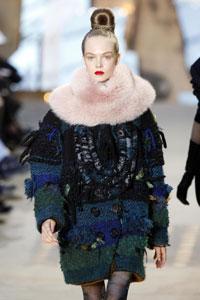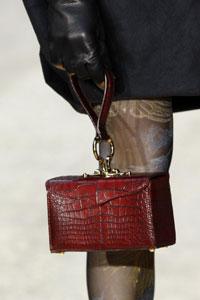The re-launch of a Russian luxury label in Paris this week neatly summarized the state of the industry: instead of a bombastic event dripping with Tsarist extravagance, the director held court in a small showroom.
After years of riding the luxury boom and thinking big -- big $1,000 handbags, big new markets -- fashion executives are learning to think small, finding hope in the humble scarf.

A model presents a creation by Christian Lacroix at Paris Fashion Week.[Agencies]
"Fashion jewelry and scarves are booming. Everything print-based, cashmere scarves, silk scarves are doing well," Geoffrey de La Bourdonnaye, chief executive of Liberty of London, told Reuters at the Christian Lacroix show.
And while some Middle Easterners and Russians are still willing to splash out on luxury, the vast Eastern riches buying the luxury market have shrunk, forcing fashion companies to scrutinize who is buying what and why.
Boutique owners and big buyers at the fashion shows were betting on small, affordable accessories for highly cautious and selective shoppers.
In the showroom of re-launched Russian luxury label Irfe, which was originally founded in the roaring 1920s, creative director Olga Sorokina voiced optimism that wealthy clients would buy her 25,000-euro fur coats and python bags decorated with the Imperial crown.
Russia's economy is expected to shrink this year after 10 years of growth, and there were noticeably fewer Russian guests at this season's shows.
CAUTIOUS TONE
Watching his wife Anastasia order Irfe coats and dresses for their boutique in Vienna, Vadim Pewsner, who works in finance, still thought the clothes would be a success.
"Russian women are not depressed. Russian men are depressed because of the crisis, but not the women. They talk about the crisis but then they are buying anyway," he said.
But with fewer private jets arriving from Moscow and New York in time for the shows, the overall tone at the catwalks and showrooms was cautious and uncertain about the future.
Tancrede de Lalun, merchandise manager for men's and womenswear for department store Printemps in Paris, told Reuters he was buying a little bit less to be ready for a possible fall in demand, but also a surprise recovery.
"There is a lot of fur at all the shows, it will definitely sell," he said, adding that handbags at the price of a designer jacket were less likely to be a hit.
Accessories are highly profitable because they take up less precious store space than clothes and do not come in awkward sizes that need to be discounted at the end of the season.

A model presents a creation by Christian Lacroix at Paris Fashion Week.[Agencies]
Sales of handbags in particular soared over the past years as emerging market clients went on a shopping spree and Europeans and Americans enjoyed broadly rising incomes.
Now, the only market for crystal-studded gowns and flashy, short dresses that is still holding up is the Middle East, despite sharply lower oil prices, buyers said.
"The high-end clientele are very frivolous in their buying so they're not holding back," said Gilbert Khoury, a buyer for the United Fashion boutique in Qatar.
And in that part of the world, the luxury handbag is unlikely ever to go out of fashion -- for cultural reasons.
While the Versace dresses and Gucci blouses have to be hidden under a veil in public, bags can be touted.
"This is the part of 'jewellery' they can show when they're with their friends," Khoury told Reuters. "They sell like hot cakes."





